 Short Answer Type
Short Answer Typea) In a typical nuclear reaction, e.g. , 
Although number of nucleons is conserved, yet energy is released. How? Explain.
b) Show that nuclear density in a given nucleus is independent of mass number A.(a) Why photoelectric effect cannot be explained on the basis of wave nature of light? Give reasons.
(b) Write the basis features of photon picture of electromagnetic radiation on which Einstein’s photoelectric equation is based.Output characteristics of an n-p-n transistor in CE configuration is shown in the figure. Determine:
(a) Dynamic output resistance
(b) DC current gain and
(c) AC current gain at an operating point VCE=10V, when IB=30 A.
A. 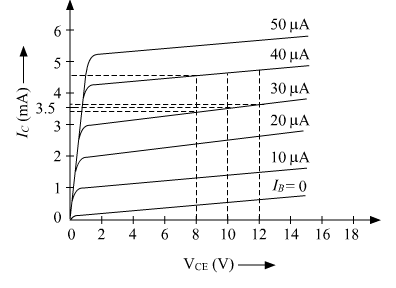
Using Bohr’s postulates, obtain the expression for the total energy of the electron in the stationary states of the hydrogen atom. Hence draw the energy level diagram showing how the line spectra corresponding to Balmer series occur due to transition between energy levels.
(a) In what way is diffraction from each slit related to the interference pattern in a double slit experiment?
(b) Two wavelength of sodium light 590 nm and 596 nm are used, in turn, to study the diffraction taking place at a single slit of aperture 2 x 10-4 m. The distance between the slit and the screen is 1.5.m. Calculate the separation between the positions of the first maxima of the diffraction pattern obtained in the two cases. Long Answer Type
Long Answer TypeWhile travelling back to his residence in the car, Dr. Pathak was caught up in a thunderstorm. It became very dark. He stopped driving the car and waited for thunderstorm to stop. Suddenly he noticed a child walking alone on the road. He asked the boy at his residence. The boy insisted that Dr. Pathak should meet his parents. The parents expressed their gratitude to Dr. Pathak for his concern for safety of the child.
Answer the following questions based on the above information:
(a) Why is it safer to sit inside a car during a thunderstorm?
(b) Which two values are displayed by Dr. Pathak in his actions?
(c) Which values are reflected in parents’ response to Dr. Pathak?
(d) Give an example of a similar action on your part in the past from everyday life.
(a) State the working principle of a potentiometer. With the help of the circuit diagram; explain how a potentiometer is used to compare the emf’s of two primary cells. Obtain the required expression used for comparing the emf’s.
(b) Write two possible causes for one sided deflection in a potentiometer experiment.
OR
(a) State Kirchhoff’s rules for an electric network. Using Kirchhoff’s rules, obtain the balance condition in terms of the resistances of four arms of Wheatstone bridge.
(b) In the meter bridge experimental set up, shown in the figure, the null point ’D’ is obtained at a distance of 40 cm from end A of the meter bridge wire. If a resistance of 10W is connected in series with R1, null point is obtained at AD=60 cm. Calculated the values of R1 and R2.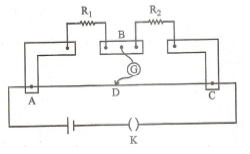
(a) Working Principle of Potentiometer
Principle:
Consider a long resistance wire AB of uniform cross-section. It’s one end A is connected to the positive terminal of battery B1 whose negative terminal is connected to the other end B of the wire through key K and a rheostat (Rh).
The battery B1 connected in circuit is called the driver battery and this circuit is called the primary circuit. By the help of this circuit a definite potential difference is applied across the wire AB; the potential falls continuously along the wire from A to B. The fall of potential per unit length of wire is called the potential gradient. It is denoted by ‘k’.
A cell e is connected such that it’s positive terminal is connected to end A and the negative terminal to a jockey J through the galvanometer G. This circuit is called the secondary circuit. In primary circuit the rheostat (Rh) is so adjusted that the deflection in galvanometer is on one side when jockey is touched on wire at point A and on the other side when jockey is touched on wire at point B.
The jockey is moved and touched to the potentiometer wire and the position is found where galvanometer gives no deflection. Such a point P is called null deflection point. VAB is the potential difference between points A and B and L meter be the length of wire, then the potential gradient is given by,
![]()
If the length of wire AP in the null deflection position be l, then the potential difference
between points A and P,
VAP = kl
Therefore, Emf of the cell = VAP= kl
In this way the emf of a cell may be determined by a potentiometer.
Comparison of two emfs’ of a cell:
First of all the ends of potentiometer are connected to a battery B1, key K and rheostat Rh such that the positive terminal of battery B1 is connected to end A of the wire. This completes the primary circuit.
Now the positive terminals of the cells C1 and C2 whose emfs’ are to be compared are connected to A and the negative terminals to the jockey J through a two-way key and a galvanometer (fig). This is the secondary circuit.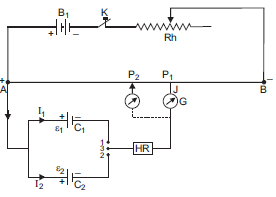
Distance if P1 from A is l1.
So, AP1 = l1
Emf of cell C1 is given by, ε1 = kl1 … (1)
Now, plug is taken from terminals 1 and 3 and inserted between the terminals 2 and 3 to bring cell C2 in the circuit. Null deflection point is obtained at P2.
Distance from P2 to A is l2.
Emf of cell C2, ε2 = kl2 … (2)
Now, dividing equation (1) by (2), we get
![]()
Out of these cells if one is standard cell.
OR
Kirchhoff’s rule states that,
(i) At any junction, the sum of the currents entering the junction is equal to the sum of the currents leaving the junction.
(ii) The algebraic sum of the charges in potential around any closed loop involving resistors and cells in the loop is zero.
Conditions of balance of a Wheatstone bridge:
P, Q, R and S are four resistance forming a closed bridge, called Wheatstone bridge.
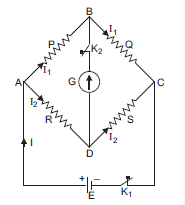
A battery is connected across A and C, while a galvanometer is connected B and D. Current is absent in the galvanometer’s balance point.
Derivation of Formula: Let the current given by battery in the balanced position be I. This current on reaching point A is divided into two parts I1 and I2. At the balanced point, current is zero.
Applying Kirchhoff’s I law at point A,
I - I1 - I 2 = 0 or
I = I1 + I 2 ...(i)
Applying Kirchhoff’s II law to closed mesh ABDA,
- I1P + I 2R = 0 or
I1P = I 2 R ...(ii)
Applying Kirchhoff’s II law to mesh BCDB,
- I1Q + I 2S = 0 or
I1Q = I 2S ...(iii)
Dviding equation (ii) by (iii), we get,
![]()
⇒ P/Q = R/S ; which is the required condition of balance for Wheatstone bridge.
b)
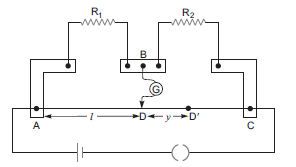
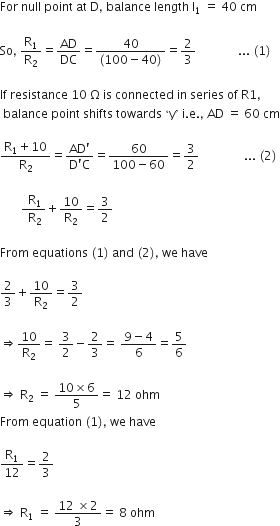
(a) Derive the expression for the torque on a rectangular current carrying loop suspended in a uniform magnetic field.
(b) A proton and a deuteron having equal momenta enter in a region of uniform magnetic field at right angle to the direction of the field. Depict their trajectories in the field.
OR
(a) A small compass needle of magnetic moment ‘m’ is free to turn about an axis perpendicular to the direction of uniform magnetic field ‘B’. The moment of inertia of the needle about the axis is ‘I’. The needle is slightly disturbed from its stable position and then released. Prove that it executes simple harmonic motion. Hence deduce the expression for its time period.
(b) A compass needle, free to turn in a vertical plane orients itself with its axis vertical at a certain place on the earth.
Find out the values of
(i) horizontal component of earth’s magnetic field and
(ii) angle of dip at the place.
(a) Draw a ray diagram showing the image formation by a compound microscope.
Hence obtain expression for total magnification when the image is formed at infinity.
(b) Distinguish between myopia and hypermetropia. Show diagrammatically how these defects can be corrected.
OR
State Huygens principle. Using this principle draw a diagram to show how a plane wave front incident at the interface of the two media gets refracted when it propagates from a rarer to a denser medium. Hence verify Snell’s law of refraction.
(b) When monochromatic light travels from a rarer to a denser medium, explain the following, giving reasons:
(i) Is the frequency of reflected and reflected light same as the frequency of incident light?
(ii) Does the decrease in speed imply a reduction in the energy carried by light wave?